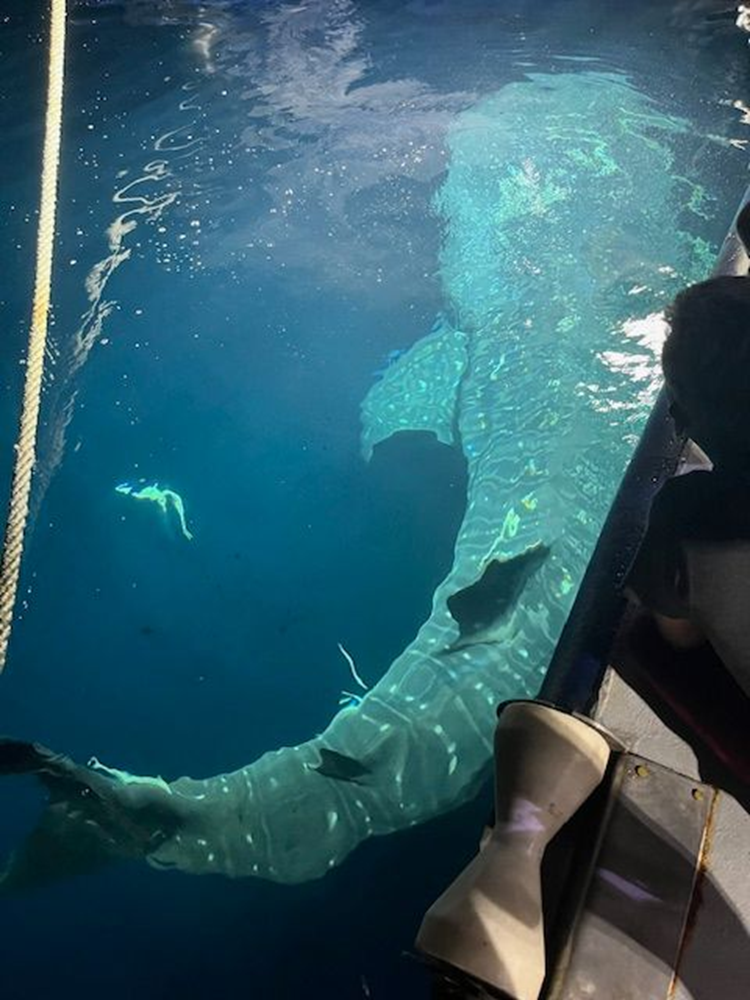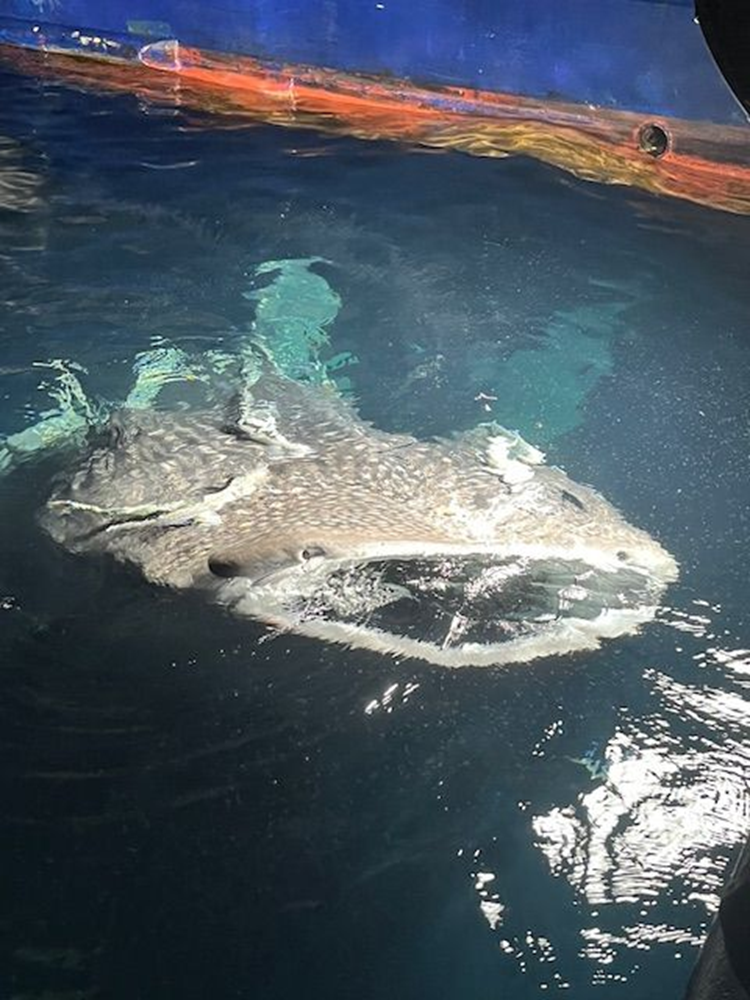Eco-Diving to Learn More About the Maldives Islands and Their Response to Sea Level Rise
- Janet Redman

- Dec 29, 2023
- 5 min read
Updated: Jan 4, 2024

IN THE MALDIVE ISLANDS--I’ve wanted to visit the Maldives ever since I saw “The Island President” movie, at Delaware’s Rehoboth Beach Film Festival in 2014. The country’s democratically elected President, Mohamed Nasheed, made the case for this small island nation on a global stage. With the average topography of the Maldives Islands being just 1 meter or so above the waters of the Indian Ocean, he appealed to the UN and developed nations for aid to save his homeland. He succeeded in elevating the attention of the world to its plight. But actual climate adaptation efforts have been a mixed bag.
In November 2023, I went on a Bucket List trip of a lifetime to the Maldives. Staying on a liveaboard ship operated by Aggressor Adventures, I went scuba-diving four or five times per day. Being a scuba-diver for just 3 years, I was anxious to see the shape of the coral reefs and marine life. In 2016, the Maldives were hit by a coral bleaching event that wiped out about 80 percent of the coral reefs. After having seen the dead, grey staghorn coral reefs in St Croix (in the US Virgin Islands), parts of Cozumel (an island off Mexico’s Yucatan Peninsula), and Hawai’i, I was braced to see destruction. The reality was anything but! It turns out that coral reefs can be resilient, when the conditions are right—when the ocean is not too hot, pollution is under control, and marine mammals stay close to their coral breeding and playgrounds. Dr. German Mendez is at the forefront of coral restoration, operating out of Cozumel Island, Mexico. More than 2000 divers have become certified in Coral Restoration through the course he teaches. In 2021, I became one of those divers. But it always felt like we were pushing a boulder uphill, cajoling coral to regenerate in an offshore nursery before transplanting pieces to a reef, tethered only by a gooey mix similar to Silly Putty. The effectiveness was dubious at best. Yet here in the Maldives, we saw brain coral, fire and fan corals, table corals, anemones and dozens of other delicate life forms assert their dominance in brilliant colors. Not to mention seeing a whale shark, the largest marine fish in the oceans (approaching 8 meters in length), which I learned is an indicator of a healthy ecosystem. Where I had expected to see a nation nearly underwater, with a marine ecosystem in dire straits, I did not.


Of the 1192 coral islands, islets, and atolls that form the equator-straddling Maldives (with only 189 inhabited), 1/3 of the 2022 population of 515,000 resides in the capital city of Male. Male is connected to a massive manmade island called Hulhumale by the “Friendship Bridge,” built by China between 2014 and 2018. It’s a needed conduit, a 6-lane bridge with two lanes devoted to cars and the other four tagged to be used by bikes and motorcycles. Due to difficult logistics, there are very few cars in the Maldives, and it seemed that there was one scooter per occupant. Surprisingly, the scooters run on gas, not electricity. When I researched this bridge, I found that it cost $200 million USD to build. There is little online about what is in it for the Chinese, other than goodwill. Suspicious, I asked our Dive Master, Shav, about it. He said that in exchange for the bridge, the Maldives gave 5 of their most remote, untouched islands to China. He did not know which ones, and in fact “giving” islands to tour companies for their exclusive rights is not unusual. All of the liveaboard boat divers were treated to dinner one night on a private island that was sold to our tour company as a resort. I appreciated it as a tired and hungry diver, but question whether these deals are made in the best interest of Maldivians.

Hulhumale has been a huge construction project, an artificial island formed by pumping sand from the seafloor. It was constructed by funding from Singapore and built in two phases. Phase I included the building of a hospital, mosque, and housing units for 50,000. It was completed in 2019, and is already at capacity. Phase II is currently underway, composed of towering color-coded high-rise apartments and a Youth Center. There are no amenities like shops, grocery stores, restaurants, or healthcare facilities—yet. It isn’t clear if these buildings are targeting local Maldivians or foreign investors, but my guess is the latter. All construction materials must be imported, as do most of the food and transportation. “Ghost gear,” and seas full of trash, are the harbinger of doom in this area of the world—the Indian Ocean and Laccadive Sea, composed of Indonesia, Sri Lanka, and India. The Maldives are overwrought with woven plastic/cotton bags that hold everything from concrete to rice. As our ship left pristine areas to return to Male, and the Velana International Airport there, these bags became more and more prevalent in the ocean.

The Maldives, an Islamic-dominated country, is Asia’s 50th-smallest population country, ahead of only Brunei. It also ranks as Asia’s smallest country by area, with only 298 square kilometers of land altogether. In 1965, ending 307 years under Portuguese, Dutch, and British colonial control, it achieved its independence. English has become an increasingly popular language, especially since significant tourism began in the early 1970s.
Home ownership is elusive for most native Maldivians, who would need an average of $3,000 per month to buy an inexpensive home for $120,000. Local buyers do receive hefty discounts to buy homes, yet most Maldivians (74 percent) rent out their homes and choose to double or triple-up in multi-generational dwellings in Phase I on Hulhumale or other islands. The COVID-19 pandemic impacted the tourism industry and therefore the local economy for the entire nation. The crew of our dive boat was 100-percent male, from the Tour Guide to the Chef, and came from a variety of countries: Maldives, Sri Lanka, India, and Bangladesh. Shav said that since conditions are horrible in Bangladesh, there are no entry requirements to the Maldives, no passport nor background check for anyone arriving from there. He said that Bangladeshians work hard, show up every day, and send their paychecks back home. There is no "anti-immigrant" movement here.

The Maldives are an island country tucked away from most of the world, roughly some 750 kilometers south of India, yet it has compassion for immigrants and the knowledge that climate change is real. They are on the frontline, but have managed somewhat of a brief reprieve, thanks to funding from Singapore, China, and a few other developed nations. The manmade island of Hulhumale will certainly survive for a few decades, due to that influx of funding, but 80% of the natural islands in the Maldives are expected to soon be underwater, by 2050. Freshwater is already a rarity, as 97 percent of the population receives water by collecting it from rain or purchasing bottled water. The next 10 years will be most telling, as the Maldives may need to bow to the influence of foreign funders who may or may not have the best interests of Maldivians at heart.
The Maldives may be able to learn from the current situation in Tuvalu, another tiny island nation, out in the Pacific Ocean, which is fast disappearing because of AGW-driven sea-level rise. Tuvalu, which had long been the British-possessed Ellice Islands till achieving full independence in 1978, recently struck a deal with Australia to let 280 native islanders migrate to Australia annually. Additionally, Australia has pledged aid of $11 million for coastal restoration and a promise to assist Tuvalu in case of a natural disaster, pandemic. or military aggression. But it comes with a catch: Canberra must agree before Tuvalu inks any security or defense deal with any other country. It is a chess game, and if Tuvalu were to enter into any agreements with China or another developed nation, Australia could pull all support for refugees or protection. While President Nasheed was successful in getting support from the UN and other nations to literally stay afloat, the final bill has yet to arrive.
















Comments